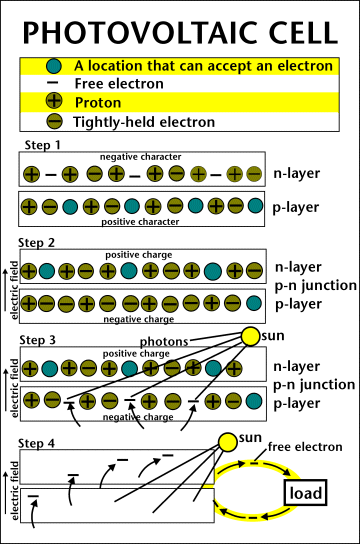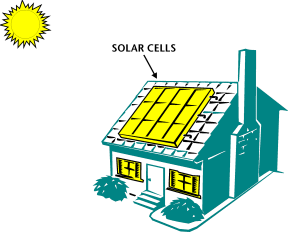|
|
||||||||||||
|
|
||||||||||||
Energy from the Sun
Photovoltaic Energy
Solar Thermal Energy
Solar Thermal Power Plants - parabolic trough, solar dish, and solar power tower
Links to Solar Materials
Renewable Slide Show - watch and listen
The sun has produced energy for billions of years. Solar energy is the sun’s rays (solar radiation) that reach the earth.
Solar energy can be converted into other forms of energy, such as heat and electricity. In the 1830s, the British astronomer John Herschel used a solar thermal collector box (a device that absorbs sunlight to collect heat) to cook food during an expedition to Africa. Today, people use the sun's energy for lots of things.
Solar energy can be converted to thermal (or heat) energy and used to:
Heat water – for use in homes, buildings, or swimming pools.
Heat spaces – inside greenhouses, homes, and other buildings.
Solar energy can be converted to electricity in two ways:
Photovoltaic (PV devices) or “solar cells” – change sunlight directly into electricity. PV systems are often used in remote locations that are not connected to the electric grid. They are also used to power watches, calculators, and lighted road signs.
Solar Power Plants - indirectly generate electricity when the heat from solar thermal collectors is used to heat a fluid which produces steam that is used to power generator. Out of the 15 known solar electric generating units operating in the United States at the end of 2006, 10 of these are in California, and 5 in Arizona. No statistics are being collected on solar plants that produce less than 1 megawatt of electricity, so there may be smaller solar plants in a number of other states.
The major disadvantages of solar energy are:
The amount of sunlight that arrives at the earth's surface is not constant. It depends on location, time of day, time of year, and weather conditions.
Because the sun doesn't deliver that much energy to any one place at any one time, a large surface area is required to collect the energy at a useful rate.
Photovoltaic energy is the conversion of sunlight into electricity. A photovoltaic cell, commonly called a solar cell or PV, is the technology used to convert solar energy directly into electrical power. A photovoltaic cell is a nonmechanical device usually made from silicon alloys.
 Sunlight is composed of photons, or particles of solar energy. These photons contain various amounts of energy corresponding to the different wavelengths of the solar spectrum. When photons strike a photovoltaic cell, they may be
reflected, pass right through, or be absorbed. Only the absorbed photons provide energy to generate electricity. When enough sunlight (energy) is absorbed by the material (a semiconductor), electrons are dislodged from the material's atoms. Special treatment of the material surface during manufacturing makes the front surface of the cell more receptive to free electrons, so the electrons naturally migrate to the surface.
Sunlight is composed of photons, or particles of solar energy. These photons contain various amounts of energy corresponding to the different wavelengths of the solar spectrum. When photons strike a photovoltaic cell, they may be
reflected, pass right through, or be absorbed. Only the absorbed photons provide energy to generate electricity. When enough sunlight (energy) is absorbed by the material (a semiconductor), electrons are dislodged from the material's atoms. Special treatment of the material surface during manufacturing makes the front surface of the cell more receptive to free electrons, so the electrons naturally migrate to the surface.
When the electrons leave their position, holes are formed. When many electrons, each carrying a negative charge, travel toward the front surface of the cell, the resulting imbalance of charge between the cell's front and back surfaces creates a voltage potential like the negative and positive terminals of a battery. When the two surfaces are connected through an external load, electricity flows.
The photovoltaic cell is the basic building block of a photovoltaic system. Individual cells can vary in size from about 1 centimeter (1/2 inch) to about 10 centimeter (4 inches) across. However, one cell only produces 1 or 2 watts, which isn't enough power for most applications. To increase power output, cells are electrically connected into a packaged weather-tight module. Modules can be further connected to form an array. The term array refers to the entire generating plant, whether it is made up of one or several thousand modules. The number of modules connected together in an array depends on the amount of power output needed.
The performance of a photovoltaic array is dependent upon sunlight. Climate conditions (e.g., clouds, fog) have a significant effect on the amount of solar energy received by a photovoltaic array and, in turn, its performance. Most current technology photovoltaic modules are about 10 percent efficient in converting sunlight. Further research is being conducted to raise this efficiency to 20 percent.
The photovoltaic cell was discovered in 1954 by Bell Telephone researchers examining the sensitivity of a properly prepared silicon wafer to sunlight. Beginning in the late 1950s, photovoltaic cells were used to power U.S. space satellites (learn more about the history of photovaltaic cells). The success of PV in space generated commercial applications for this technology. The simplest photovoltaic systems power many of the small calculators and wrist watches used everyday. More complicated systems provide electricity to pump water, power communications equipment, and even provide electricity to our homes.
Some advantages of photovoltaic systems are:
Conversion from sunlight to electricity is direct, so that bulky mechanical generator systems are unnecessary.
PV arrays can be installed quickly and in any size required or allowed.
The environmental impact is minimal, requiring no water for system cooling and generating no by-products.
Photovoltaic cells, like batteries, generate direct current (DC) which is generally used for small loads (electronic equipment). When DC from photovoltaic cells is used for commercial applications or sold to electric utilities using the electric grid, it must be converted to alternating current (AC) using inverters, solid state devices that convert DC power to AC.
Historically, PV has been used at remote sites to provide electricity. In the future PV arrays may be located at sites that are also connected to the electric grid enhancing the reliability of the distribution system.
Solar thermal(heat) energy is often used for heating swimming pools, heating water used in homes, and space heating of buildings. Solar space heating systems can be classified as passive or active.
Passive space heating is what happens to your car on a hot summer day. In buildings, the air is circulated past a solar heat surface(s) and through the building by convection (i.e. less dense warm air tends to rise while more dense cooler air moves downward) . No mechanical equipment is needed for passive solar heating.
 Active heating systems require a collector to absorb and collect solar radiation. Fans or pumps are used to circulate the heated air or heat absorbing fluid. Active systems often include some type of energy storage system.
Active heating systems require a collector to absorb and collect solar radiation. Fans or pumps are used to circulate the heated air or heat absorbing fluid. Active systems often include some type of energy storage system.
Solar collectors can be either nonconcentrating or concentrating.
1) Nonconcentrating collectors – have a collector area (i.e. the area that intercepts the solar radiation) that is the same as the absorber area (i.e., the area absorbing the radiation). Flat-plate collectors are the most common and are used when temperatures below about 200o degrees F are sufficient, such as for space heating.
2) Concentrating collectors – where the area intercepting the solar radiation is greater, sometimes hundreds of times greater, than the absorber area.
Solar thermal power plants use the sun's rays to heat a fluid, from which heat transfer systems may be used to produce steam. The steam, in turn, is converted into mechanical energy in a turbine and into electricity from a conventional generator coupled to the turbine. Solar thermal power generation works essentially the same as generation from fossil fuels except that instead of using steam produced from the combustion of fossil fuels, the steam is produced by the heat collected from sunlight. Solar thermal technologies use concentrator systems due to the high temperatures needed to heat the fluid. The three main types of solar-thermal power systems are:
Parabolic trough – the most common type of plant.
Solar energy is free, and its supplies are unlimited. Using solar energy produces no air or water pollution but does have some indirect impacts on the environment. For example, manufacturing the photovoltaic cells used to convert sunlight into electricity, consumes silicon and produces some waste products. In addition, large solar thermal farms can also harm desert ecosystems if not properly managed.
Last Revised: November 2007
Sources: Energy Information Administration, Electric Power Annual, Form EIA-860, Annual Electric Generator Report database, 2006.
EIA Main Home
Page • Related
Links • Kid's
Page Privacy • Contact
Us